The deep learning courses are the way to go if you want to learn more about artificial intelligence, machine learning, and algorithms. Today, we’ll look at the best courses for players of various skill levels.
Learn more about how I rated specific courses in the following paragraphs. Here are my recommendations.
1. Deep Learning Specialization
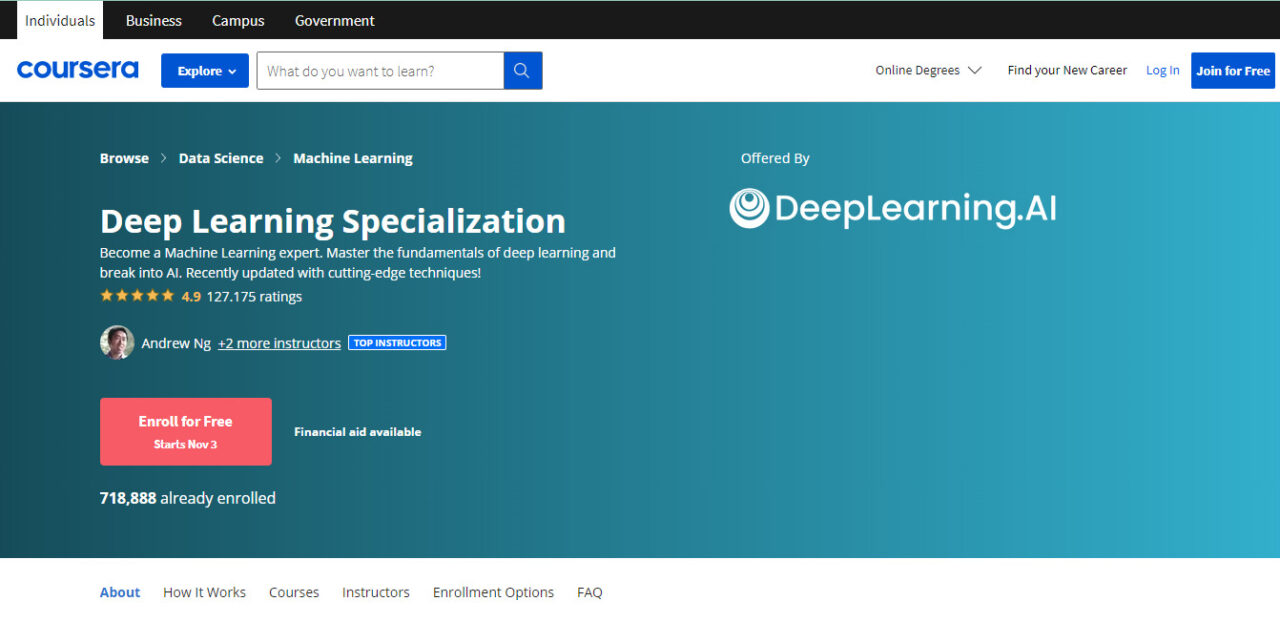
Specifications:
- Difficulty: Intermediate
- Duration: 5 months
- Price: Free
- Provider: Andrew Ng
Course’s highlights
The first class I took introduced me to the basics of deep learning. It’s fantastic to have a firm grasp on fundamentals that will help us create our algorithms.
Assignments in the programming language were well thought out. They were exciting and entertaining, but more importantly, they accomplished their goals.
In the second course in Deep Learning Specialization, I learned how to get into deep learning’s mysterious inner workings to discover the mechanisms at work in its systematic production of impressive performance gains. This course is more challenging than the first.
This course is comprehensive, yet it is not too difficult to follow. After doing it, I will know what values to check if my ML model is underperforming.
My understanding of what makes an excellent machine-learning project solidified in the third course. It made sense to me how to analyze mistakes and the many learning methods.
This course is perfect for learning the ins and outs of how to organize such “projects.” It might have been simpler to understand if the instructor had broken down the material into smaller programming tasks.
This fourth course introduced me to the fascinating field of computer vision and its many potential applications. Having at least one training example in this course that uses GPU would be fantastic.
The video lessons were straightforward, and I liked the variety of the accompanying tasks. However, some tasks that required developing code use the TensorFlow 1.0 version.
I owe an outstanding debt of gratitude to Professor Andrew and his teaching staff for designing this course and exposing me to the fascinating field of ConvNets.
Enroll Here: https://www.coursera.org/specializations/deep-learning
Pros
- Studying the foundational concept
- Sophisticatedly-designed assignments
- Detailed and informative presentation
- Variety of the accompanying tasks
Con
- Using the obsolete TensorFlow 1.0 version
2. What is Deep Learning?
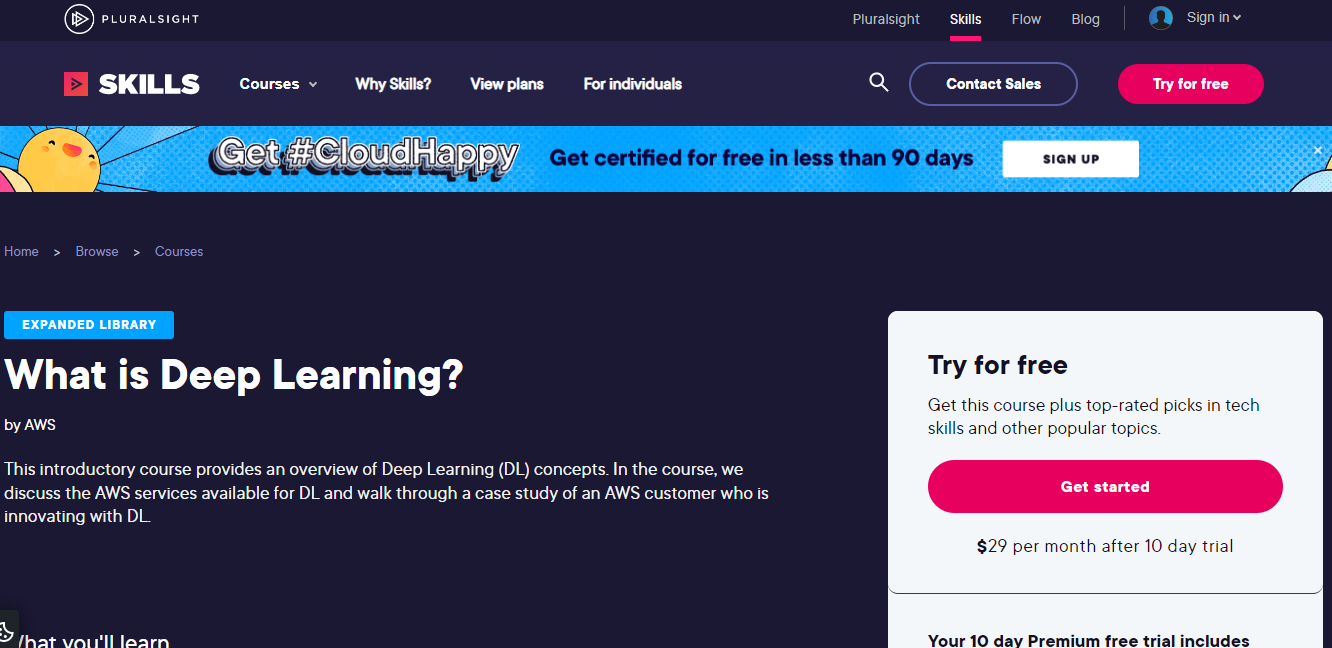
Specifications:
- Difficulty: Beginner
- Duration: 13m
- Price: Free trial
- Provider: AWS
Course’s highlights
I’m a beginner in deep learning. I found this course to be an excellent introduction. This introductory course taught me the fundamentals of Deep Learning (DL). The lecture covers a case study of an AWS client using DL to innovate and the AWS capabilities available for DL.
It’s a terrific place to begin learning about AWS and its machine-learning capabilities in a systematic way. I learned a lot of helpful information about the profession through this training.
The course provided an in-depth introduction to the AWS framework’s Deep Learning capabilities and functionalities. It offered a wealth of information for those interested in learning more about the subject.
The data was fascinating, and I learned a lot. Our teachers did a great job of breaking down the material.
Not only do they detail AWS’s many features and functions, but they also show you how to put them to good use with examples drawn straight from the real world. The experience of learning from it was positive, albeit I would have appreciated more concrete examples.
Enroll Here: https://www.pluralsight.com/courses/what-is-deep-learning
Pros
- Provide fundamentals for beginners
- Wealth of information
- Fascinating presentation
- Real-world examples
Con
- There aren’t many concrete examples.
3. Deep Learning Nanodegree
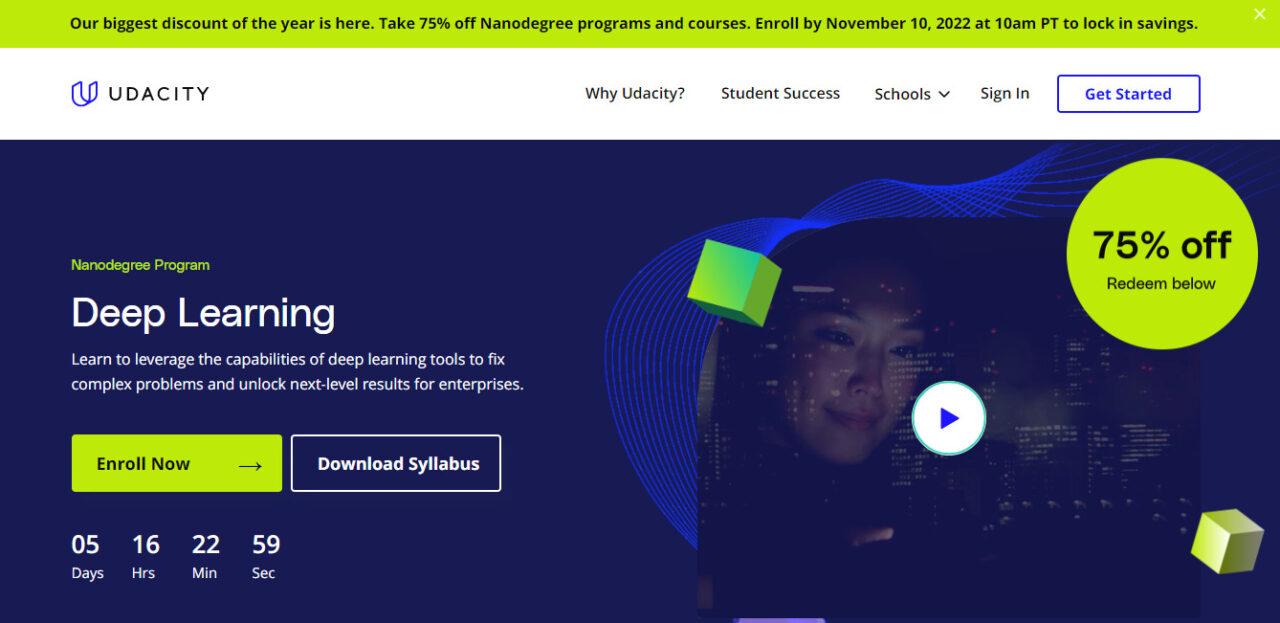
Specifications:
- Difficulty: Intermediate
- Duration: 4 months
- Price: $399 per month
- Provider: Erick Galinkin
Course’s highlights
This course covers advanced concepts, including networks, recurrent neural networks, convolutional neural networks, and generative adversarial networks.
You’ll learn in-demand IT skills via hands-on experience with real-world projects and interactive materials developed in collaboration with industry leaders.
The course lecturers have covered the depth and breadth of deep learning and neural networks. The first few weeks help you to build a solid foundation.
By the time we got to the last weeks, I felt I had a good grasp of the material. The materials they’ve developed alongside Ian Goodfellow and Andrew Trask are fantastic, and I like their emphasis on active learning.
I think this is the best user-friendly introduction to deep learning I’ve seen so far. This course covers various engaging topics, each with helpful video demonstrations and written guides.
Most of the material’s usefulness lies in the projects and introduction notes. After completing all exercises, you will have gained invaluable knowledge in the field of computer programming.
You’ll walk away from the exercise with functioning code that you can modify and use in future projects and maybe a boatload of new ideas.
All of the material in this course is fantastic. The projects seemed like a great opportunity to learn how to design several neural network architectures.
On the whole, nevertheless, the assignments and lectures are nicely organized. It’s also worth your time to review the helpful advice, recommendations, and conversations in the forums and slack channel.
I’ll be honest that I’ve found this course challenging. To complete my Nanodegree, I had to confront and conquer my phobias and insecurities.
I am pleased with the course since it is still fantastic and beneficial.
Enroll Here: https://www.udacity.com/course/deep-learning-nanodegree–nd101
Pros
- Hands-on experience
- Informative materials
- Learner-friendly syllabus
- A wide range of engaging topics
- Practical projects and introduction notes
- Well-organized assignments and lectures
Con
- Challenging knowledge
4. Deep Learning Fundamentals
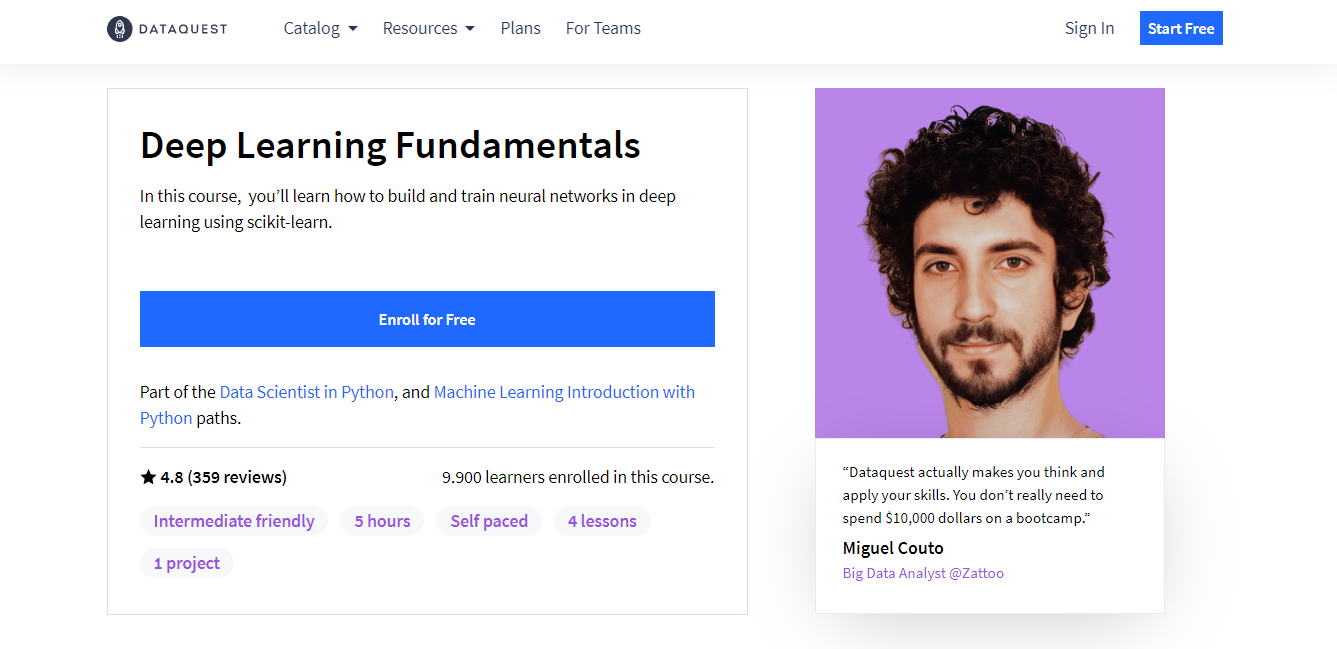
Specifications:
- Difficulty: Intermediate
- Duration: 5 hours
- Price: Free
- Provider: Miguel Couto
Course’s highlights
This course covers concepts of neural networks, such as graph representation and activation functions. It also introduces Nonlinear activation functions, such as the ReLU function.
The course culminating experience is a project you work on during the semester. You will construct a neural network to categorize photographs of numbers from the MNIST dataset.
Applying what you’ve learned in this course to the construction of neural networks in a standard Deep Learning process is the focus of this project. As a bonus, you may use this work to showcase your abilities to potential employers.
Everything is accessible even to complete newcomers. I’ve attempted deep learning previously without success since I had any prior experience with it.
This course was crucial in my education. Overall, I like the environment here.
The instructor lays everything out clearly and easily understood. The more time I spent doing the work, the more motivated I became to keep studying.
The material presented in this course was both exciting and valuable. It is a good start for beginners.
The instructor’s content is fantastic, and he exposes the concepts very clearly. My only complaint is that it’s too short to learn more.
Enroll Here: https://www.dataquest.io/course/deep-learning-fundamentals/
Pros
- Reality projects
- Basics of neural networks
- Combination of theory and practice
- Clear and well-organized material
- Different types of nonlinear activation functions
Con
- Short content
5. Neural Networks and Deep Learning
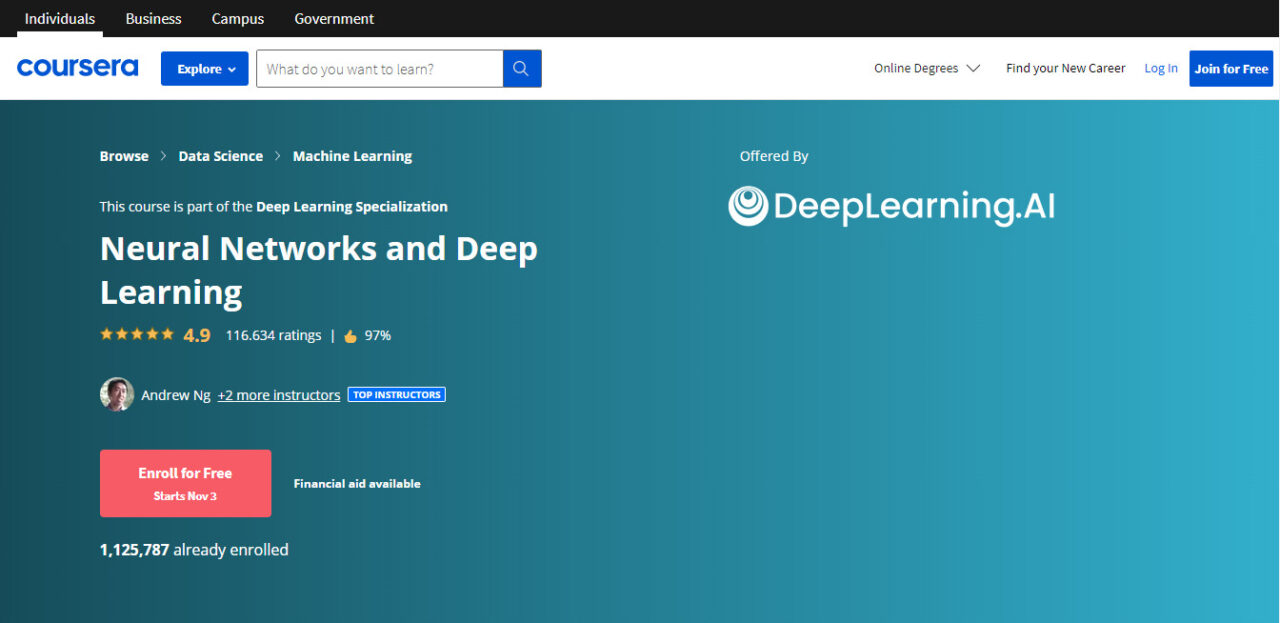
Specifications:
- Difficulty: Intermediate
- Duration: 29 hours
- Price: Free
- Provider: Andrew Ng
Course’s highlights
You will be well-versed in the significant technical fueling the rapid expansion of deep learning. You will learn how to create, train, and use deep neural networks with all their connections.
This four-week course will teach you how to use vectorized neural networks effectively in your projects. It allows you to use deep learning in your applications by isolating critical parameters in a neural network’s design.
It ranks high among the courses I’ve ever taken. The instructor has straightforwardly and accurately facilitated training.
I would much appreciate a list of supplementary readings for each video. Even the assigned homework is educationally beneficial.
The tasks are completed in a standardized setting thanks to Python Jupyter notebooks. The downside is that it conceals some abstractions.
While the notebooks are downloadable as.py files, this prevents you from seeing how the code would appear in a Python IDE.
Most of the code is already developed, and your involvement in each assignment is limited to writing a few lines of code. Learning what is occurring throughout the software installation process requires extensive independent research.
However, there was a considerable amount of pre-written code, so it didn’t push me to think creatively. So, I didn’t fully understand the material, but I still managed to get good scores.
This course is a great place to start with NN, provided you have a basic understanding of Python.
Enroll Here: https://www.coursera.org/learn/neural-networks-deep-learning
Pros
- Employing caching and vectorization for speed
- The ability to comprehend the inner workings of brain networks
- An instructor explains things clearly and thoroughly
- The explanation is clear and straightforward.
Con
- Lack of stimulating learner’s creativity
6. Deep Learning on AWS
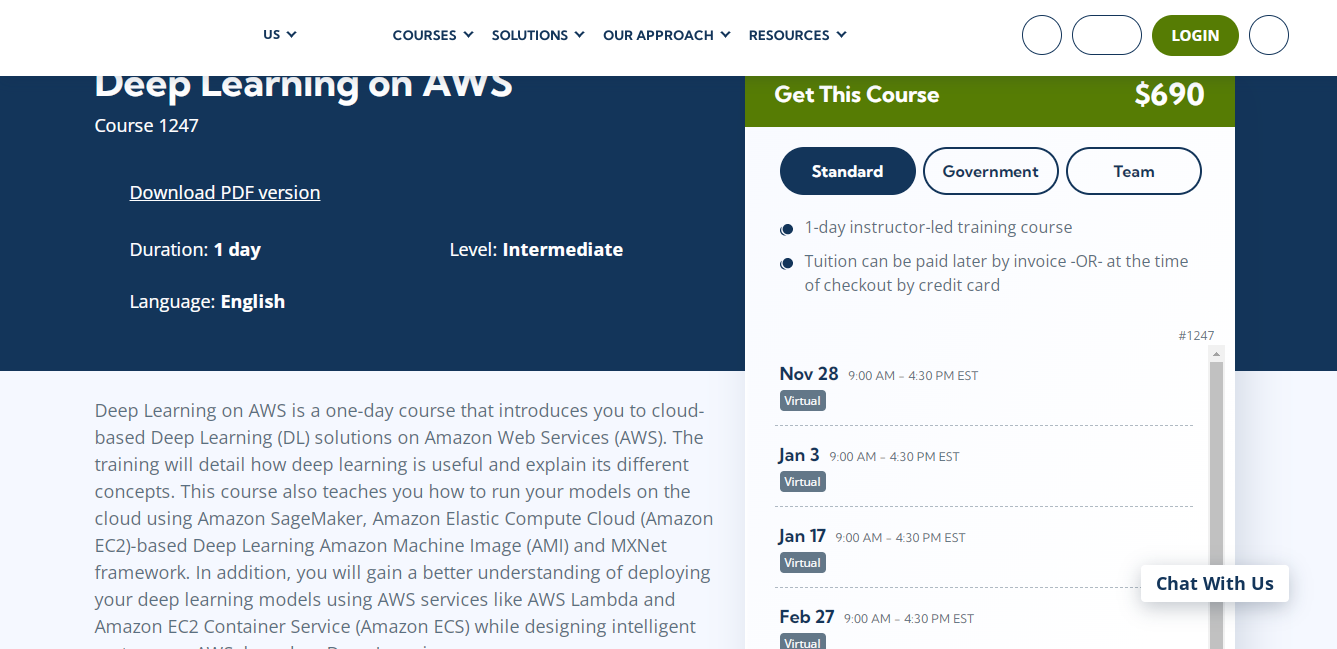
Specifications:
- Difficulty: Intermediate
- Duration: 1 day
- Price: $690
- Provider: Course 1247
Course’s highlights
This one-day session will expose you to Amazon Web Services’ Deep Learning services in the cloud. The course will explain the many ideas of deep learning and illustrate its many applications.
The course also covers using Amazon SageMaker and other cloud-based technologies for model execution. You will also learn how to use AWS services like AWS Lambda to deploy your deep learning models.
This course does a great job of not just explaining the many AWS parts but also showing how to put them all to good use via the use of real-world applications. The use cases are beneficial for teaching the concepts and inspiring ideas for using them in one’s projects.
The instructor put a lot of effort into educating, and it shows. The training gave me significant hands-on experience in my chosen sector.
I appreciate that it has plenty of helpful information for newcomers to the field. However, I would have learned more from another paid course that included practical applications and in-depth assessments.
Enroll Here: Currently Unavailable
Pros
- Learning what deep learning is
- Recognizing the ideas in a deep learning setting
- Using the Amazon SageMaker and MXNet frameworks
- Adjusting AWS services to accommodate deep learning implementations
Con
- No hands-on exercises and thorough exams
7. Deep Learning Professional Certificate
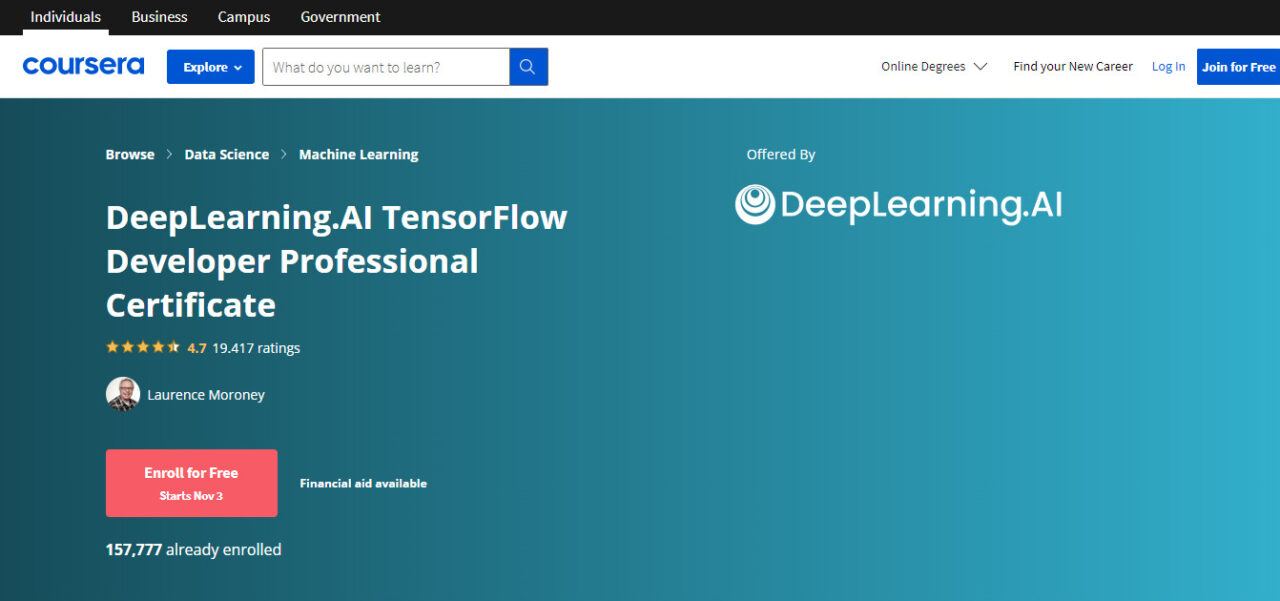
Specifications:
- Difficulty: Intermediate
- Duration: 4 months
- Price: Free
- Provider: Laurence Moroney
Course’s highlights
TensorFlow’s open-source deep learning framework is among the most sought-after and widely used software packages.
You will learn how to use machine learning using TensorFlow to construct and refine robust models during the course work.
These four courses make up a Professional Certificate program that will teach you how to use TensorFlow to create AI-powered apps that can scale.
Once you’ve completed the course, you’ll be able to use your newfound knowledge of TensorFlow in various situations.
This Professional Certificate consists of four individual classes. Courses like “Introduction to TensorFlow,” “Convolutional Neural Networks,” “Natural Language Processing,” and “Sequences” are all a part of this bundle.
You’ll learn the fundamentals in the introductory course and then advance to more advanced material. Understanding CNN better was a great benefit to me.
It is an excellent study program. However, I need some improvements to Google’s co-working assignments.
Laurence Moroney has created a fantastic course called Convolutional Neural Networks in which he details the steps necessary to develop ConvNets using the software Tensorflow. The course’s value lies in the fact that I may use all the concepts presented in practice.
The topic of sequence models was treated in depth in the Natural Language Processing class. All the videos and reading materials were interesting, and the notebooks provided a lot of helpful contexts.
Having the opportunity to study Sequences is fantastic. It aided me in expanding my understanding of time-series data and cutting-edge techniques for developing predictive models.
The course is excellent; the included notebooks and videos work together to strengthen students’ grasp of the material. The video’s audio is underwhelming, so turn up the volume.
Enroll Here: https://www.coursera.org/professional-certificates/tensorflow-in-practice
Pros
- Covering real-life ideas
- Machine learning skills with TensorFlow
- Build scalable AI-powered applications
- Well-explanatory materials, notebooks
Con
- Low video sound
8. Deep Learning with Python
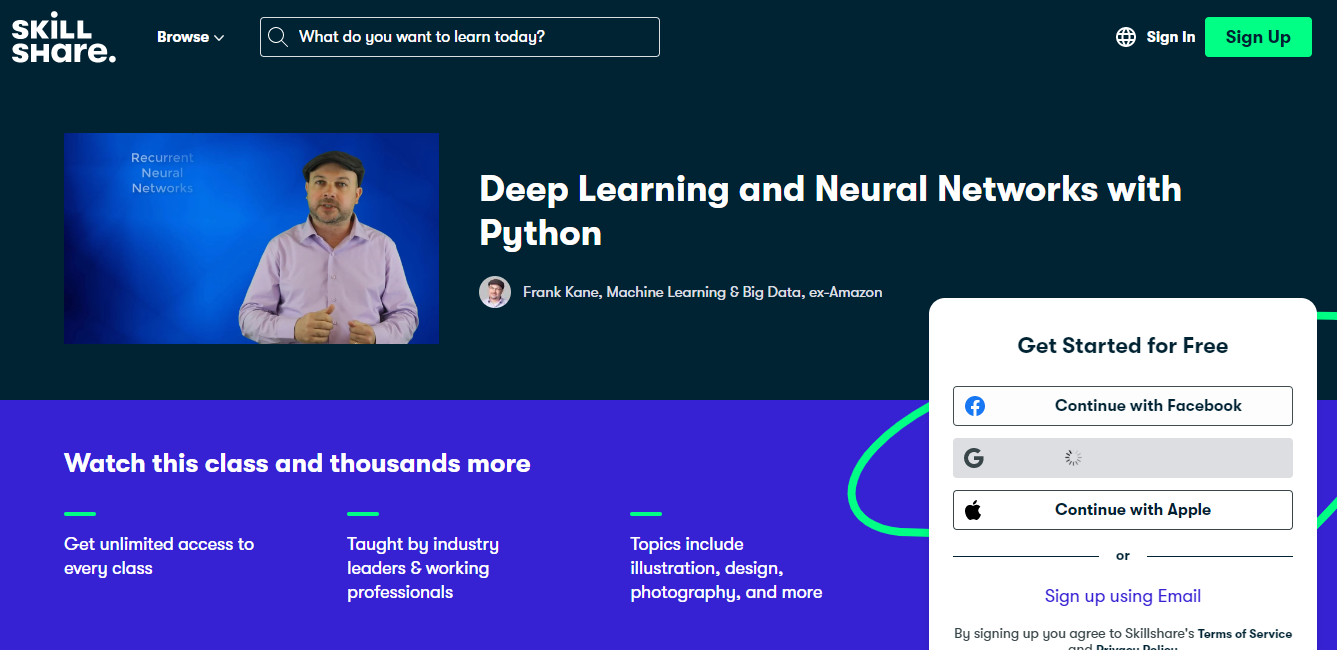
Specifications:
- Difficulty: Intermediate
- Duration: 4 hours 24 minutes
- Price: Free trial
- Provider: Frank Kane
Course’s highlights
This course will demystify this fascinating topic for those with prior Python familiarity. A total of 25 courses are available, covering issues including ANNs, Tensorflow, Keras, and more.
It is more than just theory! In addition to working on the group project, you’ll also participate in various mini-projects and exercises along the way.
You can learn neural networks to know how to recognize handwriting. You may also try to build deep neural networks and experiment with various topologies in an interactive environment.
It’s excellent for those who want to learn the fundamentals of Deep Neural Networks. It had all the same features as the introductory Machine Learning with Python course I took on skillshare.
The course provides enough background on the topics at hand without overwhelming students with irrelevant material. The instructor explains many topics and words in a style that is easy to understand while yet being comprehensive.
It is not too lengthy so that you won’t get bogged down in unnecessary details. But it offers a surprisingly significant amount of knowledge directly applicable to the topic.
The course is excellent since it is straightforward and provides a firm foundation for future exploration into deep learning. However, it would be beneficial to provide more projects and examples.
Enroll Here: https://www.skillshare.com/en/classes/Deep-Learning-and-Neural-Networks-with-Python/45606211
Pros
- Concise content
- Giving you enough information
- Clear and well-organized material
- Demystifying a lot of terms and concepts
- Allowing you to use the model you produced
Con
- Fewer projects and examples
9. Build Deep Learning Models
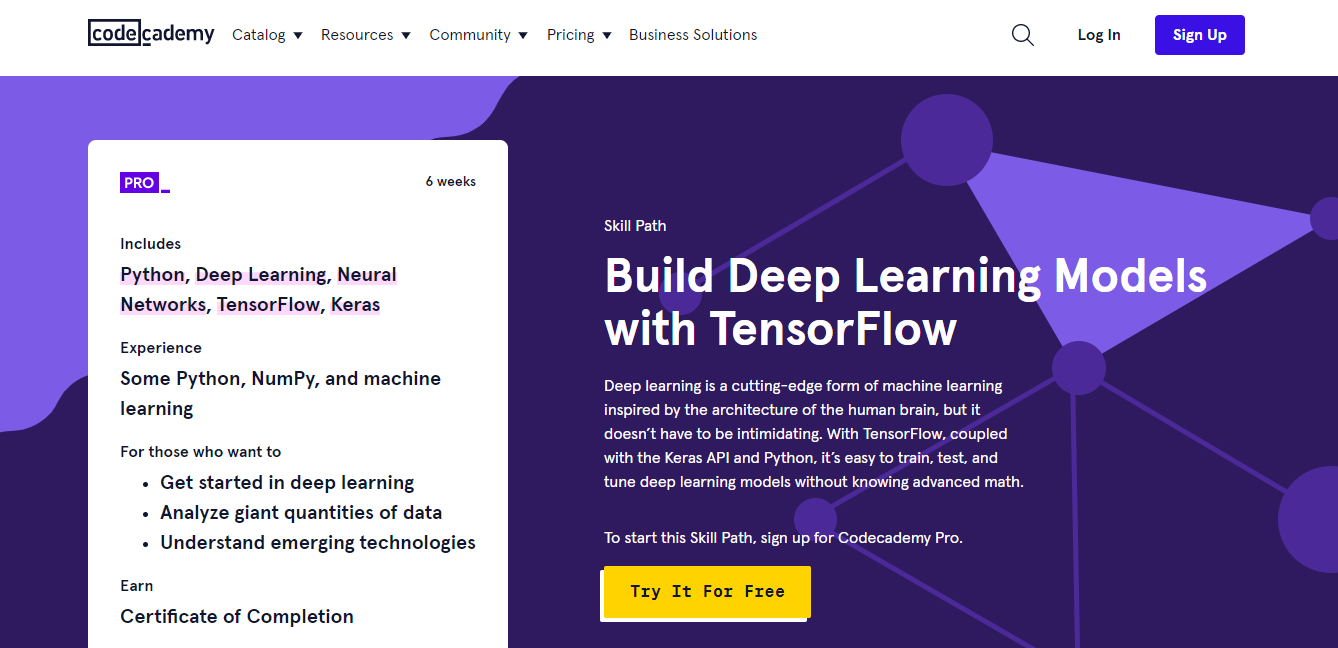
Specifications:
- Difficulty: Beginner
- Duration: 6 weeks
- Price: Free trial
- Provider: Unknown
Course’s highlights
Deep learning is a relatively straightforward machine learning technique that takes its cues from the structure of the human brain.
Training, testing, and tuning deep learning models is simple, using TensorFlow and the Keras API in combination with Python.
Newcomers to deep learning may begin to grasp the ideas behind the method. You may train your deep learning models using data from the real world.
This course covers seven lessons, including Tensorflow skills, neural networks, and Portfolio Projects. TensorFlow is a necessary skill to help you to build your neural networks.
Then, you may go even further into how to put your newfound knowledge to work in the real world. You may create your deep learning challenge as part of your portfolio.
The videos are professionally produced, offering a clear and brief overview of the various learning approaches. The instructor provides well-written and straightforward codes.
Still, he has to dissect the codes, line by line, to grasp them fully. That’s what I want to do for the foreseeable future.
The classes don’t simplify too much but rather equip you to go further on your own if you so want. However, there are several typos, grammatical mistakes, and unclear questions on the quizzes and tests throughout the lectures.
Anyway, I feel like I’ve learned much after just seven classes. I could get started immediately, work at my speed, and review the lectures as much as I wanted, all for a fraction of the time and expense of a traditional university course.
I feel like I have a foundation on which to build, so it was worth it.
Enroll Here: https://www.codecademy.com/learn/paths/build-deep-learning-models-with-tensorflow
Pros
- Practicing with projects
- Professionally-produced videos
- Well-written and straightforward codes
- TensorFlow and the Keras API, in combination with Python
Cons
- Some unclear questions
10. Leveraging Deep Learning
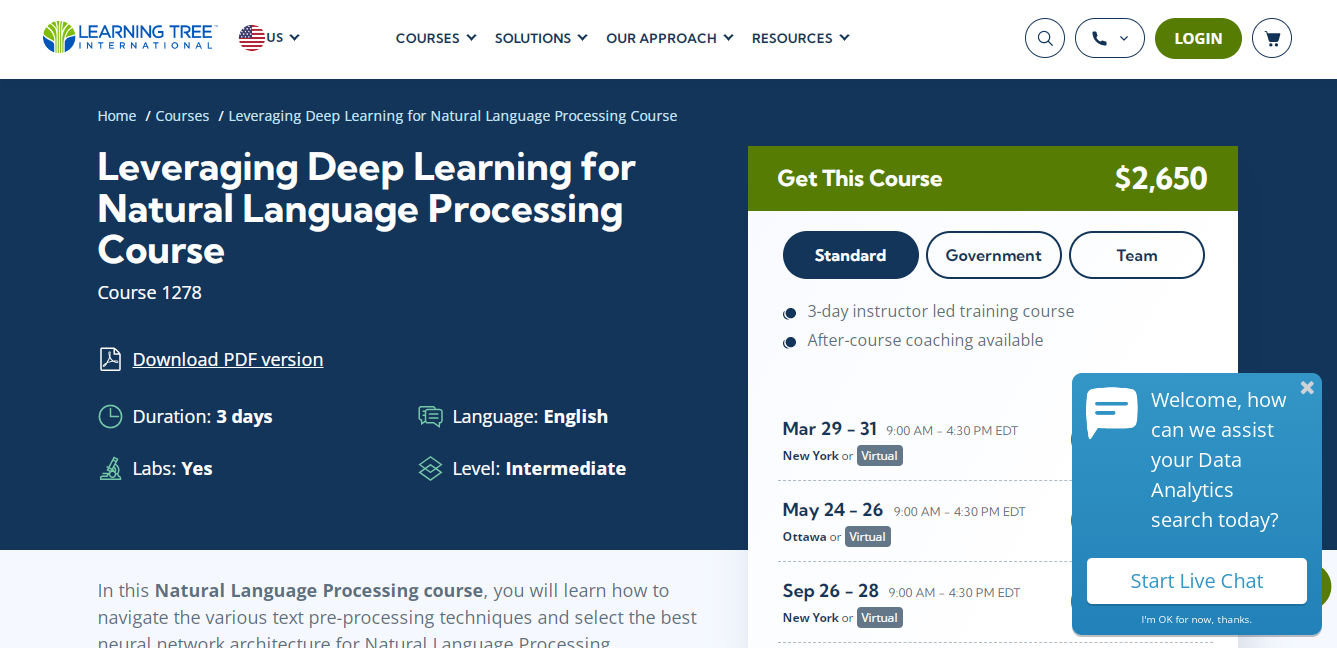
Specifications:
- Difficulty: Intermediate
- Duration: 3 days
- Price: $2,650
- Provider: Learningtree
Course’s highlights
This course will introduce students to the basics of deep learning and NLP. It covers popular text preprocessing methods, the fundamentals of Natural Language Processing, and their applications.
It will further demonstrate how to use word embeddings and display dense word vectors in TensorFlow Projector. You will learn to categorize movie reviews and headlines using recurrent neural networks and convolutional neural networks.
This course on Leveraging Deep Learning for Natural Language Processing requires students to have a foundation in Data Science, Machine Learning & AI. In addition, it employs Jupyter and Keras for NLP model construction.
Artificial intelligence increasingly relies on text and speech input from humans. By the end of the course, you will have the knowledge and ability to take raw data and turn it into meaningful figures.
Yet, a solid working understanding of Introduction to Python training is required for success in this course. So, I don’t recommend this course for beginners.
Enroll Here: https://www.learningtree.com/courses/deep-learning-natural-language-processing
Pros
- Word embeddings
- Display dense word vectors
- Popular text preprocessing methods
- Jupyter and Keras for NLP model construction
- Fundamentals of Natural Language Processing
Con
- The course requires knowledge of Python.
Learning Guide
In this section, we’ll lay out a comprehensive plan for your education in Deep Learning. This guidance is helpful for both novices who are short on time and practicing professionals who have already put in serious effort.
This road map has two stages:
- Get a bird’s eye view of Deep Learning
You work on tasks that don’t need a lot of arithmetic. If you want a bird’s-eye perspective of the Deep Learning environment, you must prioritize building exciting things above math and theory.
- Explore the Depths of Deep Learning
At this point, you must familiarize yourself with mathematics and machine learning fundamentals. You will have the opportunity to work on challenging projects that will stretch your theoretical knowledge and feature sets.
What follows are some suggestions I have for newcomers to the profession.
- Don’t be afraid of math.
If math isn’t your thing, below are several ways you may accomplish it.
- Learn linear algebra thoroughly.
- Take some time to relax with some probability theory.
- Let’s begin with linear regression.
- Get fluent in Python, C, C++, or Java so you can put all those algorithms to use.
- Master dataset preprocessing, feature extraction, parameter tuning, and developing your intuitive sense.
- Learn about DL frameworks and how they function.
You will be ready to tackle a real-world situation only once you’ve mastered all this stuff.
- Implement projects according to your ability
Instead of attempting to absorb everything at once, focus on areas where you will get the most tangible benefits from deep learning strategies. You’ll stay motivated if you’re working on a project that has personal meaning for you.
If you’re looking for some inspiration for your first project, here are a few ideas:
Try your hand at Computer Vision if you like the visual arts. Neural networks aid in various image analysis tasks, including object classification, feature extraction, emotion recognition, and face age estimation.
Afterward, focus on Automatic Speech Recognition (ASR) and natural language processing. Machine translation is now a trendy area of study.
Google Translate’s enhanced quality is due in large part to deep learning. Neural networks have just lately begun to help address language-related difficulties.
- Challenge yourself.
There is a lot of rivalry in machine learning. Taking part in an ML competition is the most accurate approach to gauge your level of expertise in the field.
You may learn from your sophisticated competition, make new connections, and raise your profile in this way.
FAQs
Which platform is best for deep learning?
The most widely used technology for Machine Learning and Deep Learning is Google’s open-source TensorFlow framework.
Is Netflix using deep learning?
Netflix makes predictions about its users’ viewing habits using machine learning algorithms.
Which is better, Machine Learning or Deep Learning?
Compared to deep learning, applications built using machine learning are easier to implement and run on regular PCs. Deep understanding needs far more robust hardware and data than traditional learning systems.
Is Tesla using deep learning?
Tesla is using deep learning and data from the real world to develop its technology.
Is Python good for deep learning?
Several advantages make Python the ideal language for AI and machine learning research. It helps make AI and ML projects easier to understand and implement by providing convenient entry to high-quality library and framework resources.
Final Thoughts
In conclusion, the course “What is Deep Learning?” provided by AWS is my recommendation for starters. This entry-level course provides an overview of Deep Learning, preparing you for a solid foundation in this field.
I’ve done my best to cover the top ten deep learning courses in this post. Use the comments box below to ask me anything you want to know.
